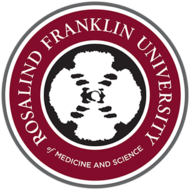Rosalind Franklin University of Medicine and Science
|
Former names
|
Finch University |
|---|---|
| Motto | Life in Discovery (Vita In Inventione) |
| Type | Private |
| Established | Predecessors established 1912. |
| President | K. Michael Welch, MB, ChB, FRCP |
|
Academic staff
|
1,303 |
| Students | 2,157 (2013-2014) |
| Location | North Chicago, Illinois, USA |
| Campus | Urban, 97 acres |
| Alumni | over 17,000 (as of 2014) |
| Colors | Maroon, Black, and White |
| Website | rosalindfranklin |
Rosalind Franklin University of Medicine and Science (RFUMS) is a nonprofit, private, interprofessional graduate school located in North Chicago, Illinois. It has more than 2,000 students in five schools: the Chicago Medical School, the College of Health Professions, the College of Pharmacy, the School of Graduate and Postdoctoral Studies, and the Dr. William M. Scholl College of Podiatric Medicine.
The university is named for famous DNA crystallographer Rosalind Franklin. Photo 51, Dr. Franklin's X-ray diffraction pattern for B-DNA, was pivotal in the history of biology in the twentieth century, and this photograph is the basis for the university's seal and logo.
The university offers over 29 study programs in graduate health-related subjects, including PhD programs for medical and basic research.
Facilities include a multi-media laboratory, a virtual microscopy lab, a simulation lab, and the Education and Evaluation Center, with high-tech opportunities for education and research.
The University is located to the west of the Naval Station Great Lakes and to the south of the Captain James A. Lovell Federal Health Care Center.
The precursor of RFUMS, then known as The Chicago Hospital-College of Medicine, was founded in Chicago in 1912. A group of physicians and community leaders formed a non-profit school to serve those medical students who were able to attend only at night. William Dorland, editor of the well-known medical dictionary bearing his name, was dean of the School for a time.
The School had its most noteworthy period of development under the direction of Dr. John J. Sheinin, who served as dean and president from 1932 to 1966. The institution successfully met the challenges arising from the restructuring of American medical education following the Flexner Report, a time period in which more than half of all American medical schools merged or closed. In 1930, the School, by then known as the Chicago Medical School, moved to what would become one of the world’s largest aggregations of medical facilities. Located in downtown Chicago, this complex contained two undergraduate universities, three medical schools, seven hospitals, and colleges of dentistry, pharmacy, and nursing.
...
Wikipedia

